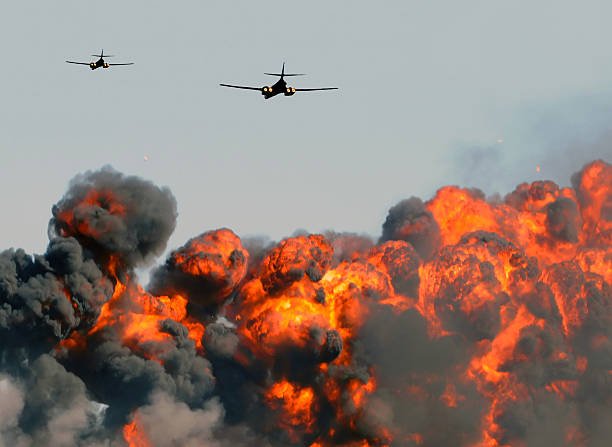Iran Attacked a US Military Base: In a dramatic escalation of tensions in the Middle East, Iran has launched an attack on a US military base, sending shockwaves through global diplomatic and defense circles. This event is not an isolated incident but the latest development in a long, complex, and hostile relationship between Iran and the United States. In this article, we’ll explore the recent attack, its motivations, and the historical events that led to this confrontation.

The Attack: What Happened?
In June 2025, Iranian forces targeted a US military base located in eastern Syria using drones and short-range missiles. According to initial reports, several American personnel were injured, and infrastructure was damaged. The Iranian state media described the strike as a “retaliatory operation,” while US officials called it a “deliberate provocation” and a “threat to regional security.”
Why Iran attacked a US Military Base?
-
Response to Israeli-Gaza Conflict
Since October 2023, the Israeli-Gaza war has intensified, with the US strongly backing Israel. Iran, a long-time supporter of Palestinian resistance groups like Hamas and Hezbollah, sees American military and logistical support to Israel as a direct act of aggression. Iran has warned several times that the US must “bear the consequences” of its involvement. -
Revenge for Targeted Killings
Iran alleges that a top Iranian commander was recently killed in an airstrike in Syria, which it claims was carried out under US coordination. The attack on the US base is seen as direct retaliation for that incident. -
Proxy Warfare Strategy
Iran has been engaging in a “proxy war” with the US across the region using militias and groups such as Hezbollah, the Houthis in Yemen, and Iraqi Shia groups. The attack fits within this larger strategy of avoiding full-scale war while consistently pressuring American forces.
The Long History of US-Iran Conflict:
-
1953 Coup
The US and UK orchestrated a coup to overthrow Iran’s democratically elected Prime Minister Mohammad Mossadegh, reinstating the Shah. This sowed the seeds of long-term distrust and animosity among the Iranian people. -
1979 Islamic Revolution & US Embassy Crisis
After the Islamic Revolution, Iran took 52 Americans hostage at the US Embassy in Tehran for 444 days. This event permanently scarred US-Iran relations and led to a complete diplomatic break. -
Iran-Iraq War (1980–1988)
During this brutal conflict, the US supported Iraq, further deepening Iran’s suspicions of American intentions in the region. -
Killing of Qassem Soleimani (2020)
One of the most pivotal moments in recent US-Iran tensions came when the US killed top Iranian General Qassem Soleimani in a drone strike in Baghdad. Since then, Iran has vowed to avenge his death and has carried out or backed several attacks on US interests in the region.
Current Strategic and Regional Implications:
-
Strait of Hormuz at Risk
Iran’s aggressive posture directly affects the Strait of Hormuz — a critical waterway through which 20% of the world’s oil passes. Any military escalation could disrupt global oil supplies and trigger a new energy crisis. -
Iran’s Alliance with Russia and China
Iran is increasingly aligning itself with anti-US powers like Russia and China. Military exercises, defense pacts, and trade deals have strengthened Iran’s strategic depth and emboldened its foreign policy moves. -
Questions on US Policy
Critics argue that the US’s long-term military presence in the Middle East has yielded more hostilities than stability. The continued targeting of American bases suggests a shift in regional dynamics where Iran feels more confident in directly challenging US power.
What Happens Next?
-
Diplomacy or Further Conflict?
So far, both sides have refrained from declaring war, but the situation remains extremely volatile. Without immediate de-escalation or diplomatic negotiations, the risk of a full-blown military conflict looms large. -
Global Reactions
The United Nations, EU, and countries like India and Turkey have called for restraint and peace talks. However, no significant diplomatic breakthrough has been reported yet. -
Impact on Global Economy
Following the attack, oil prices surged by nearly 7%, reflecting fears of broader instability in the oil-rich region. A prolonged conflict could have serious implications for the global economy, especially for oil-importing nations.
Iran’s attack on a US military base is more than just a retaliatory strike—it’s a reflection of decades of unresolved tensions, ideological differences, and regional power struggles. As both nations stand at a dangerous crossroads, the world watches with anxiety. Will diplomacy prevail, or are we heading toward another devastating conflict in the Middle East? The coming weeks will be critical in determining the direction of this crisis. For now, one thing is certain: peace in the region remains fragile, and a single misstep could ignite a much larger fire.
ऐसे और भी एक्सप्लेनर लेखों के लिए हमारे साथ जुड़े रहें! Khabari bandhu पर पढ़ें देश-दुनिया की ताज़ा ख़बरें — बिज़नेस, एजुकेशन, मनोरंजन, धर्म, क्रिकेट, राशिफल और भी बहुत कुछ।
UAE Closes Its Airspace Amid Iran-U.S. Tensions, Major Flight Disruptions Reported

